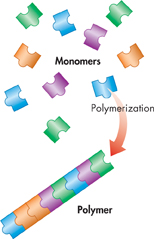Macromolecules
 What are the functions of each of the four groups of macromolecules?
What are the functions of each of the four groups of macromolecules?
Many of the organic compounds in living cells are so large that they are known as macromolecules, which means “giant molecules.” Macromolecules are made from thousands or even hundreds of thousands of smaller molecules.
Most macromolecules are formed by a process known as polymerization (pah lih mur ih ZAY shun), in which large compounds are built by joining smaller ones together. The smaller units, or monomers, join together to form polymers. The monomers in a polymer may be identical, like the links on a metal watch band; or the monomers may be different, like the beads in a multicolored necklace. Figure 2–13 illustrates the process of polymerization.
Biochemists sort the macromolecules found in living things into groups based on their chemical composition. The four major groups of macromolecules found in living things are carbohydrates, lipids, nucleic acids, and proteins. As you read about these molecules, compare their structures and functions.
BUILD Vocabulary
WORD ORIGINS Monomer comes from the Greek words monos, meaning “single,” and meros, meaning “part.” Monomer means “single part.” The prefix poly- comes from the Greek word polus, meaning “many,” so polymer means “many parts.”

FIGURE 2–13 Polymerization When monomers join together, they form polymers. Using Analogies How are monomers similar to links in a chain?

FIGURE 2–14 Carbohydrates Starches form when sugars join together in a long chain. Each time two glucose molecules are joined together, a molecule of water (H2O) is released when the covalent bond is formed.
Carbohydrates Carbohydrates are compounds made up of carbon, hydrogen, and oxygen atoms, usually in a ratio of 1 : 2 : 1.  Living things use carbohydrates as their main source of energy. Plants, some animals, and other organisms also use carbohydrates for structural purposes. The breakdown of sugars, such as glucose, supplies immediate energy for cell activities. Many organisms store extra sugar as complex carbohydrates known as starches. As shown in Figure 2–14, the monomers in starch polymers are sugar molecules.
Living things use carbohydrates as their main source of energy. Plants, some animals, and other organisms also use carbohydrates for structural purposes. The breakdown of sugars, such as glucose, supplies immediate energy for cell activities. Many organisms store extra sugar as complex carbohydrates known as starches. As shown in Figure 2–14, the monomers in starch polymers are sugar molecules.
▸ Simple Sugars Single sugar molecules are also known as monosaccharides (mahn oh SAK uh rydz). Besides glucose, monosaccharides include galactose, which is a component of milk, and fructose, which is found in many fruits. Ordinary table sugar, sucrose, consists of glucose and fructose. Sucrose is a disaccharide, a compound made by joining two simple sugars together.
Table of Contents
- Formulas and Equations
- Applying Formulas and Equations
- Mean, Median, and Mode
- Estimation
- Using Measurements in Calculations
- Effects of Measurement Errors
- Accuracy
- Precision
- Comparing Accuracy and Precision
- Significant Figures
- Calculating With Significant Figures
- Scientific Notation
- Calculating With Scientific Notation
- Dimensional Analysis
- Applying Dimensional Analysis




